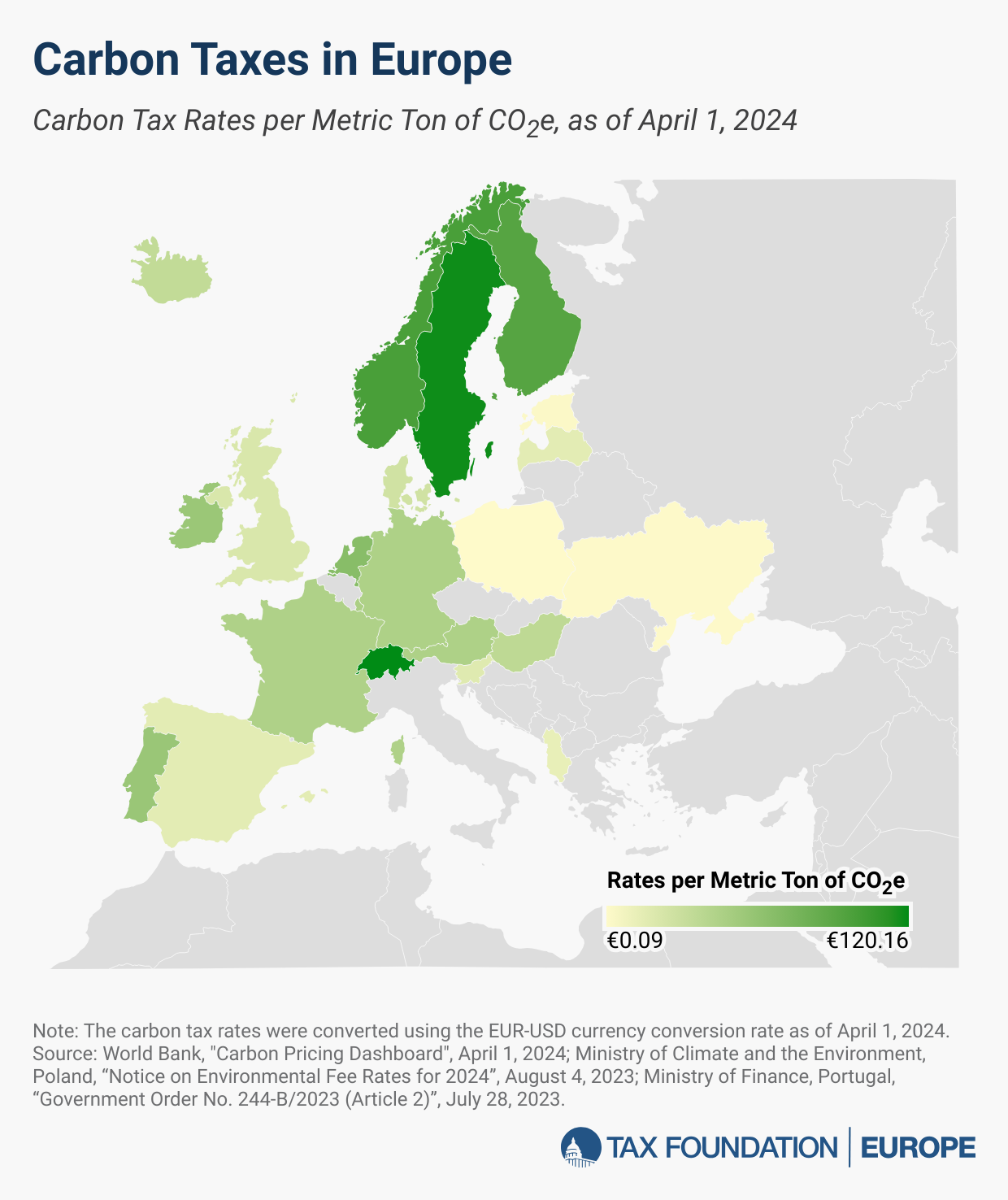In recent years, several countries have taken measures to reduce carbon emissions, including instituting environmental regulations, emissions trading systems (ETSs), and carbon taxes. In 1990, Finland was the world’s first country to introduce a carbon taxA carbon tax is levied on the carbon content of fossil fuels. The term can also refer to taxing other types of greenhouse gas emissions, such as methane. A carbon tax puts a price on those emissions to encourage consumers, businesses, and governments to produce less of them.
. Since then, 23 European countries have implemented carbon taxes, ranging from less than €1 per metric ton of carbon emissions in Ukraine to more than €100 in Sweden, Liechtenstein, and Switzerland.
Switzerland and Liechtenstein currently levy the highest carbon taxA tax is a mandatory payment or charge collected by local, state, and national governments from individuals or businesses to cover the costs of general government services, goods, and activities.
rate at €120.16 ($130.81) per ton of carbon emissions, followed by Sweden (€115.34, $125.56) and Norway (€83.47, $90.86). The lowest carbon tax rates can be found in Poland (€0.09, $0.10) and Ukraine (€0.72, $0.77). The average carbon tax rate among the 23 European countries was €49.23 as of April 1, 2024.
Carbon taxes can be levied on different types of greenhouse gases, such as carbon dioxide, methane, nitrous oxide, and fluorinated gases. The scope of each country’s carbon tax differs, resulting in varying shares of greenhouse gas emissions covered by the tax. For example, Spain’s carbon tax only applies to fluorinated gases, taxing only 2 percent of the country’s total greenhouse gas emissions. Albania, Liechtenstein, and Luxembourg, by contrast, cover more than 72 percent of their greenhouse gas emissions.
All Member States of the European Union (plus Iceland, Liechtenstein, and Norway) are part of the EU Emissions Trading System (EU ETS), a market created to trade a capped number of greenhouse gas emission allowances. With the exception of Switzerland, Ukraine, and the United Kingdom, all European countries that levy a carbon tax are also part of the EU ETS. Switzerland has its own ETS, which has been tied to the EU ETS since January 2020. Following Brexit, the UK implemented its own UK ETS in January 2021.
In several countries—for example, Estonia, Finland, Latvia, and Norway—the national carbon tax baseThe tax base is the total amount of income, property, assets, consumption, transactions, or other economic activity subject to taxation by a tax authority. A narrow tax base is non-neutral and inefficient. A broad tax base reduces tax administration costs and allows more revenue to be raised at lower rates.
overlaps with the emission base also covered by the EU ETS, leading to harmful double taxationDouble taxation is when taxes are paid twice on the same dollar of income, regardless of whether that’s corporate or individual income.
of the overlap. When national carbon taxes apply to emissions covered by an ETS, they tend to shift the emissions to sources outside of their tax base, leaving total emissions capped by ETS allowances unchanged.
Some countries apply multiple excise taxes or ETSs to sources of carbon emissions at different implicit or explicit tax rates. In these cases, the table below displays the highest applicable rate. Ideally, a carbon tax should apply to the carbon emissions of all sectors at the same rate.
Several European countries have introduced a carbon tax or an ETS in recent years. Germany and Austria have implemented carbon taxes in 2021 and 2022, respectively, that will be phased into ETSs by 2026. Albania and Hungary have implemented carbon taxes in 2022 and 2023, respectively. The autonomous region of Catalonia is considering a carbon tax at the subnational level.
Carbon taxes have long been magnets for political controversy. But from an economic standpoint, they deserve to be taken seriously. And as with anything in tax policy, the details and design matter greatly.
Stay informed on the tax policies impacting you.
Subscribe to get insights from our trusted experts delivered straight to your inbox.
Share
Previous Versions
-
Carbon Taxes in Europe, 2023
4 min read
-
Carbon Taxes in Europe, 2022
3 min read
-
Carbon Taxes in Europe, 2021
2 min read
-
Carbon Taxes in Europe, 2020
3 min read
-
Carbon Taxes in Europe, 2019
3 min read
